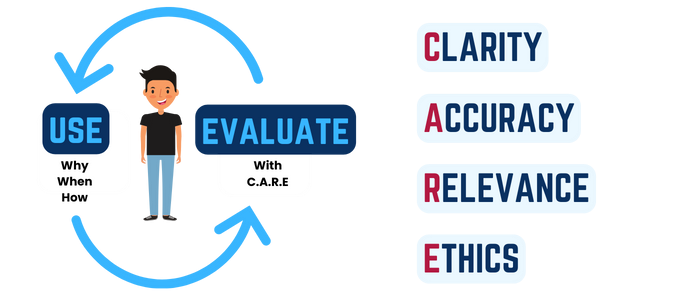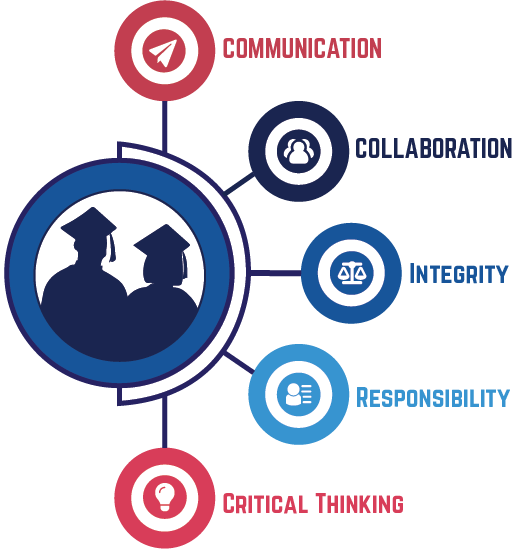Information Technology
Page Navigation
What is Artificial Intelligence (AI)?
-
Artificial Intelligence is a rapidly evolving field that offers many opportunities and challenges for education. AI refers to machines or software that can perform tasks that typically require human intelligence, such as problem-solving and decision-making. AI is a tool that can enhance human capabilities and improve learning outcomes, but it also comes with limitations and risks that need to be addressed and regulated, including accuracy, reliability, fairness, transparency, accountability, and its implications on society, ethics, laws, and the environment.
Types of AI
-
- Reactive AI
- Tools that respond to specific inputs or situations without learning from past experiences.
- Examples: Alexa, Roomba, chess-playing computer
- Tools that respond to specific inputs or situations without learning from past experiences.
- Predictive AI
- Tools that analyze historical datya and experiences to predict future events or behaviors.
- Examples: Netflix, credit-scoring systems
- Tools that analyze historical datya and experiences to predict future events or behaviors.
- Generative AI
- Tools that generate new content or outputs, often creating something novel from learned patterns.
- Generative AI is the focus of our guidance because it is so new and has tremendous implications on education, and the workforce.
- Examples: ChatGPT, Gemini, Claude
- Reactive AI
AI Literacy Stance
-
In recognition of the rapidly evolving technological landscape and its significant impact on the global workforce, Agua Fria HSD commits to the integration of Artificial Intelligence (AI) tools and skills across our district. As we prepare our students for a future where AI will be universal, it is our responsibility to ensure they are not only proficient but also ethical and responsible users of AI technology.
Our Commitment
- Inclusive Access: Guarantee that every student, irrespective of background, has access to AI tools and learning resources, ensuring equitable opportunities for all to engage with and understand AI.
- Curriculum Integration: Embed AI Literacy within existing subjects, introducing students to the fundamentals of AI, its applications, and its implications. Explore how the power of AI can transform the way we teach, assess, and learn.
- Teacher Training: Equip our educators with the necessary knowledge and tools to effectively teach AI concepts, supported by ongoing professional development in cutting-edge AI education practices.
- Ethical Considerations: Foster an understanding of the ethical dimensions of AI use, emphasizing critical thinking about the consequences and responsibilities associated with AI technologies. After many iterations of data and conversations, we adopted our AI Literacy Framework. We focus on how, when, and why we use AI as well as how to evaluate the output with CARE (clarity, accuracy, relevance, and ethics
- Partnerships: Collaborate with technology leaders, higher education institutions, and other organizations to keep our curriculum relevant and enriched with real-world applications.
- Career Preparation: We want students graduating prepared to utilize AI in their chosen career pathway.
- Community Education and Training: Engage and educate parents/guardians about AI Literacy, providing them with the tools and knowledge to support their child's learning and to navigate the AI landscape effectively.
AI Literacy Stance Evaluation and Adaptation
-
Our AI stance will be reviewed annually to adapt to technological advancements and in response to feedback from our community. This iterative process will ensure that our educational practices remain at the forefront of AI Literacy education.
AI Literacy Framework
-
Use and Evaluate AI with CARE
This framework is used for staff and students to become more AI Literate so that they may safely, and effectively integrate this technology into their working. AI Literacy is gained through the continual cycle of using and evaluating AI outputs with CARE. Knowing why, when, and how to use AI, as well as critically evaluating its outputs are essential in today’s technology driven, AI-advanced world.

AI Acceptable Use Framework
-
AI Stoplight
This framework is used to explain to students how they are allowed to use AI Tools for each assignment.
Students should not use Generative AI to produce or edit their work without explicit permission from the teacher, and must give credit to the AI tool for what it did. Any submission of content coming from AI without proper permission and credit will be viewed as a violation of academic integrity.
The default for all classrooms is “Red Bot” unless specifically directed by a teacher.
*Staff and students should refrain from entering personally identifiable information into an AI application.
AI & AFUHSD Portrait of a Graduate
-
-
 Communication: Students can use AI-driven language translation tools to communicate with peers globally, breaking language barriers and fostering a more inclusive dialogue. AI-powered writing assistants can help students refine their writing, ensuring clarity and coherence in their essays and presentations.
Communication: Students can use AI-driven language translation tools to communicate with peers globally, breaking language barriers and fostering a more inclusive dialogue. AI-powered writing assistants can help students refine their writing, ensuring clarity and coherence in their essays and presentations. -
Collaboration: AI can work as an additional thought partner in a collaborative group where students can use AI to generate ideas, outlines, and generally assist the team in completing a task.
-
Integrity: AI can support integrity by providing unbiased feedback and highlighting ethical considerations in decision-making processes. Students can use AI to generate and analyze arguments on both sides of an issue before reaching a conclusion.
-
Responsibility: Generative AI can help students break down large projects into manageable tasks, creating detailed plans and timelines that encourage students to take responsibility for completing each step on time.
-
Critical Thinking: AI can enhance critical thinking by providing problem-solving activities and adaptive learning modules that challenge students to apply their knowledge in new and complex ways.
-
AI & Digital Citizenship
-
As more staff and students begin using AI technologies, it is essential for our schools to adopt a culture of digital citizenship, aligned with AFUHSD’s Portrait of a Graduate. Navigating the digital world ethically, responsibly, and effectively is a key part of a student’s education. This prepares them to become global communicators, effective collaborators, upstanding citizens who embody integrity and responsibility online, and critical thinkers who use rigorous strategies to decipher the truth. We are committed to training our staff to be better Digital Citizens in order for our students to develop these skills.
Many students spend the majority of their day online and AI will soon be integrated into their school, work, and entertainment, if it is not already. AI Literacy and Digital Citizenship curriculum will be specifically taught in the Freshman Experience in order to best prepare our students for the rest of high school, and beyond to meet the need of the 21st century world.
AFUHSD & OpenAI Edu Partnership
-
Agua Fria Union High School District (AFUHSD) is excited to announce a partnership with OpenAI to provide staff with secure access to ChatGPT's premium features. As the first public high school district in the country to offer these resources, this collaboration aims to:
- Offer a safe and secure platform for staff to enhance efficiency.
- Promote AI literacy among educators.
- Guide students in responsible AI use.
This innovative tool will empower teachers to effectively align with academic goals, improve instructional practices, and ultimately enhance student learning.

